De Montfort University
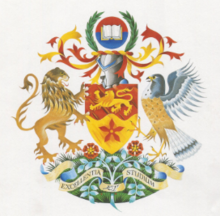 Coat of Arms | |
Former names | Leicester School of Art Leicester Colleges of Art and Technology Leicester Polytechnic |
|---|---|
| Motto | Latin:Excellentia et studium |
Motto in English | Excellence and Zeal |
| Type | Public |
| Established | 1870 1992 –university status |
| Endowment | £2.56 million (2022)[1] |
| Budget | £234.6 million (2021–22)[1] |
| Chancellor | Akram Khan |
| Vice-Chancellor | Katie Normington |
| Students | 27,915 (2022/23)[2] |
| Undergraduates | 21,160 (2022/23)[2] |
| Postgraduates | 6,750 (2022/23)[2] |
| Location | , England |
| Affiliations | |
| Website | dmu |
 | |
De Montfort University Leicester(DMU) is apublic universityin the city ofLeicester,England. It was established in accordance with theFurther and Higher Education Actin 1992 as a degree awarding body. The name De Montfort University was taken fromSimon de Montfort,a 13th-centuryEarl of Leicester.
De Montfort University has approximately 27,000 full and part-time students, 3,240 staff and an annual turnover in the region of £168 million.[3]The university is organised into four faculties: Art, Design, and Humanities (ADH); Business and Law (BAL); Health and Life Sciences (H&LS); and Computing, Engineering and Media (CEM). It is a Sustainable Development Hub, focusing on Peace, Justice and Strong Institutions, an initiative by theUnited Nationslaunched in 2018. TheDepartment for Educationawarded the university an overall Silver rating in the 2023Teaching Excellence Framework.[4]It is a member of theAssociation of Commonwealth Universities.
History
[edit]Origins
[edit]The university's origins are in the Leicester School of Art, established in 1870 on a voluntary basis. The school expanded in response to the changing needs of late 19th-century industry; leading to the introduction of subjects such as engineering, building andmachine drawing.[5]By 1897, it was clear the buildings being used were no longer suitable. £25,000 was raised to build 'a very handsome school that would be enormous credit to the town and... so that it would answer its purpose for the next 100 years'. The building in question is the Hawthorn Building, which today still houses the sciences; in the shape of the Faculty of Health and Life Sciences. At the time of the first phase its construction, there were 500 art students and 1,000 technical students. In 1903, a letter fromHis Majesty's Inspectorpraised the success of the technical subjects. Increasing demand for courses prompted an extension to the Hawthorn Building in 1909. In 1919, further properties were rented. TheDuchess of Atholllaid the foundation stone of Hawthorn's new west wing in 1927; by which time the establishment was known under by the joint name ofThe Leicester Colleges of Art and Technology.[5]
In 1930, the college was recognised for the external degree course inPharmacyof theUniversity of London,and the Pharmaceutical Chemist Diploma of theRoyal Pharmaceutical Society of Great Britain.In 1934, the University of London recognised the college as suitable for preparing students for the External Degree in Engineering, and so the courses on offer developed apace. The prospectus for 1936–37 included details of various technically based schools, including the Schools of Architecture, Building and Building Crafts, and Engineering.[5]The fourth phase of extensions to the Hawthorn Building was completed in 1938–39. The first accommodation was secured in 1946 when three houses were purchased by the university.[6]
More space was needed to meet the academic demand, and so in 1948, F. Bray, Under Secretary of theMinistry of Education,opened the converted Downings Warehouse. In 1966, the new Fletcher building was opened byThe Queen Mother.In the same year, awhite paper,"A Plan for Polytechnics and Other Colleges", was published, leading to the creation of theCity of Leicester Polytechnic.Under the provision of theEducation Reform Act 1988,Leicester Polytechnic became a Higher Education Corporation, withDame Anne MuellerappointedChancellorin June 1991.[5]
Leicester Polytechnic became De Montfort University in accordance with theFurther and Higher Education Actin 1992, establishing it as a degree-awarding body in its own right.[7][8]
Name
[edit]
The name De Montfort University was chosen in allusion toSimon de Montfort,Earl of Leicester,a prominent figure in establishing theParliament of Englandin the 13th century.[6]Honouring Simon de Montfort has been controversial, as in 1231 heexpelled the Jews from Leicester.By taking his name the university's commitment to community values has been questioned.[9][10][11][12]
Expansion and contraction
[edit]In the 1990s the institution aimed to become a multi-campuscollegiate universitycovering the entireEast Midlands,and as such, the university swiftly acquired other campuses. Leicester Polytechnic built a new campus in Kents Hill inMilton Keynes,across the road from theOpen University– the first brand-new higher education campus built in Britain for twenty years. This took its first students in 1991 and was officially opened byQueen Elizabeth IIin 1992, prior to the official foundation of De Montfort University as aNew University;it was branded The Polytechnic: Milton Keynes until it became De Montfort University Milton Keynes. Departments at Milton Keynes includedComputer and Information Sciences,Built Environment and Business.
In 1994 De Montfort University took over the higher education activities of theBedford College of Higher Education,while the further education section remained independent under the nameBedford College.The university absorbed theLincolnshire College of ArtinLincoln,and theLincolnshire College of Agriculture and HorticultureinCaythorpe, Lincolnshirein 1994; and theRiseholme Agricultural CollegeinRiseholme, Lincolnshireand the Leicester-based Charles Frears College of Nursing and Midwifery in 1995.
Since 2000, the university's expansionist policy has been reversed, with all outlying campuses being sold off. The Bedford campus merged with theUniversity of Lutonto form theUniversity of Bedfordshire;the campuses in Lincolnshire were transferred to theUniversity of Lincoln;and the Milton Keynes campus was closed in 2003, with its buildings taken over by the Open University. The institution divested itself of its last outlying site, Charles Frears (on London Road in Leicester), in 2011, when the nursing school moved to the city centre campus.
Present day
[edit]The university has approximately 27,000 full and part-time students, 3,240 staff and an annual turnover in the region of £168 million.[3]Its campus comprises ten halls of residence offering around 3,000 university sourced rooms, and is approximately a ten-minute walk from Leicester city centre.
The proceeds from the campus sales have been ploughed back into the Leicester City Campus, which has consequently seen a large amount of development, including the construction of two new buildings and the extensive refurbishment of a third, the Edith Murphy building (formerly Bosworth House) to house the students and staff of the School of Nursing and Midwifery, previously based at Charles Frears.
The Performance Arts Centre for Excellence (PACE), funded by a £4.5 Million grant from theHigher Education Funding Council for England,was opened in 2007 by the BBC's Creative DirectorAlan Yentob.[13]A new building for the Faculty of Business and Law – the Hugh Aston building – designed byCPMG Architectsopened in September 2009. The new Business and Law centre has the Magazine Square at its centre and cost £35 million.[14]
The university's new £8 million sports facility, named the Queen Elizabeth II Diamond Jubilee Leisure Centre, was opened on campus on 30 July 2012 by Vice-ChancellorDominic Shellard.
The former John Sandford Site was renovated to a conference and events centre called The Venue@DMU. This was opened in September 2015.
A new Arts and Design building opened in the centre of the Campus in September 2016, the Vijay Patel Building (also byCPMG Architects), which is split into the Arts Tower and the Design Wing. At the same time the pedestrianised roads through the campus were turned into grassed/paved walkways.
In 2019 Vice-Chancellor Shellard resigned in advance of anOffice for Studentsreport which found serious and systematic failures in governance under his leadership.[15]
Campus
[edit]
110yds
The Leicester campus is close toLeicester Castleand occupies what was once a religious precinct of the castle, built by the earls and dukes of Lancaster, known as the Newarke.[17]It is bordered by the 15th-centuryMagazine Gatewayor Newarke Gateway[18]and the campus contains listed buildings, including Trinity House, rebuilt in 1901 and containing part of the original 14th-century Hospital of The Annunciation building.[19]The Hawthorn Building contains the ruins of the 1353Church of the Annunciation of Our Lady of the Newarke,where the body ofKing Richard IIIis said, according to early sources,[20]to have been displayed before his burial atGreyfriars.The ruins form the centrepiece of the De Montfort University Heritage Centre, opened in March 2015. As well as the ruins, the Centre also celebrates the history of the university and contemporary student work.
The campus has seen several recent developments as part of a ten-year £200 million initiative by the university, such as the £35 millionHugh AstonBuilding; constructed to move students from the Faculty of Business and Law closer to the centre of the university's infrastructure.[21]
In 2016, the Vijay Patel Building was opened. The Vijay Patel Building is home to art and design courses and is the centrepiece of the £136 million Campus Transformation Project which aims to "provide DMU with one of the finest city centre campuses in the country". The building is named after Dr Vijay Patel, who, alongside his wife, made the single largest donation by individuals in the university's history.[22]
Campus Centre
[edit]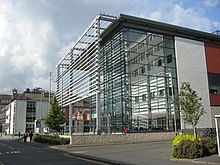
The Campus Centre offers numerous facilities for students. The building was completed in September 2003, fulfilling a number of functions and providing a wide range of services. The building is a three-floor building designed by Ellis Williams Architects, the company responsible for theBaltic Centre for Contemporary Artin Gateshead. It was constructed on the site of the old Stibbe building, at a cost of £8.5 million and is central to the university's 'Masterplan', which seeks to regenerate the Leicester campus environment.[23] It houses the De Montfort University Students' Union, comprising various societies such asDemon FM[24]a student radio station; Demon TV;[25]and The Demon,[26]a student-run newspaper published fortnightly through term time. It also has a Student Night Club called Injunction with two rooms on the second floor.
The Union operates a lettings agency in a joint venture with the University of Leicester Students Union. The service which operates from both campuses is known as SULETS.[27]
Library and Learning Services
[edit]The four Library sites on campus consist of the main Kimberlin Library and three ancillaries. Many Library functions are also available off campus at any time, including electronic resources such as academic databases, and online account management facilities such as book renewal.
The Kimberlin Library is a four-storey building opened in 1977, extended in 1997 and extensively refurbished in 2007. The ground floor Learning Zone was opened as part of the 2007 refurbishment and provides space for group and individual work. Kimberlin Library has an overallseating capacityof around 1250. The upper floors of the library cater for more traditional Quiet and Silent study needs.[28]Further investment in 2011 saw the opening of the library Archives and Special Collections rooms and a dedicated Research Postgraduate Study Room. There are also facilities including dedicated study rooms for students with disabilities and special needs.[29]
The Eric Wood Learning Zone is in the ground floor of the adjacent Eric Wood Building, was extended and developed into a second Learning Zone, providing 180 more study places. This was opened on 12 January 2009.
The Law Library is situated in the Hugh Aston Building which opened in September 2009, Leicester Law School is one of only a few in the country to have a dedicated Law Library on site within the teaching building[citation needed].One room within this library houses the separate Legal Practice Course library, to which only students on that course have access.
Organisation and governance
[edit]Faculty of Art, Design and Humanities
[edit]
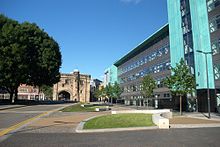
Created from a merger of the previous Faculty of Art and Design and the Faculty of Humanities, the Faculty of Art, Design and Humanities offers traditional humanities subjects including English and History, as well as more design based courses in areas such as Architecture and Fine Art.
Within its humanities division, the Faculty currently holds five National Teacher Fellows; the latest being Deborah Cartmell, Reader in English, who was made a Fellow in recognition of excellence in teaching and learning support. Cartmell developed the university's pioneering Master's degree inAdaptation Studiesand is a founding member of theBritish Shakespeare Associationand the Association of Adaptation Studies.[30]
Subjects of the humanities are taught within the Clephan Building, which was refurbished specifically for the Faculty's use. The Clephan Building plays host to theCultural Exchangesevent, which features guests and speakers from the arts, media, literature, politics and film. It began in 2000, and attracts upwards of 4,000 visitors annually. Recent visitors to the festival have included the screenwriter and novelistAndrew Davies,famous for his work in the field of adaptation; novelistAdele Parks,a highly acclaimed women's fiction author nominated for the Romantic Novelist of the Year award; andJanet Street-Porter,a British media personality, journalist, television presenter and producer.[31]
Recently, the Faculty has collaborated with two other European universities to offer a new Master's course, based in its International Centre for Sports History and Culture: the MA Management, Law and Humanities of Sport. Organised by Centre International d'Etude du Sport (CIES) and endorsed byFIFA,the course was created to promote management education within the sports world. It is ostensibly recognised as one of the top graduate programmes in sport, The Humanities of Sport module is organised by the International Centre for Sport History and Culture at De Montfort, whilst the Management of Sport module is taught bySDA Bocconi School of Managementin Italy and the final Sports Law module byUniversité de Neuchâtelin Switzerland. Course patrons have includedJoseph S. Blatter,Lord Coe,Sir Bobby CharltonandSergey Bubka.As of 2010, the course has produced more than 200 graduates from over 70 different nations.[citation needed]
The Faculty boasts the only university courses in the world to specialise in lingerie,underwear,body-wear,swimwearand performance sportswear,[32]which first began after the Second World War. The Faculty also offers the only UK university courses in Footwear Design.[33]
Faculty of Business and Law
[edit]The Faculty of Business and Law incorporates the Leicester Castle Business School and the Leicester De Montfort Law School. The Faculty has a long history of international partnerships; in 1997, it collaborated to help found a business school in India – theDaly CollegeBusiness School.[34]
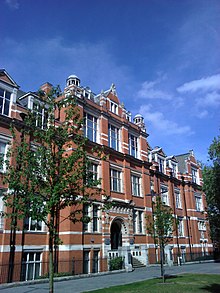
The Leicester Business School was regarded byThe Sunday Timesas one of the top 10 business schools in the UK,[35]whilst the 2007National Student Surveyranked it seventh out of 110 institutions for student satisfaction.[36]
It comprises more than 4000 students and 150 academic staff, making it one of the larger providers of business and management education in the UK.
The Faculty of Business and Law is based in the Hugh Aston Building; a £35 million investiture opened in March 2010. The construction of the building released the 14th-century Magazine Gateway from four lanes of traffic, allowing a tree-lined square to be created; the Magazine Square.
The building's namesake,Hugh Aston,died in November 1558 and was a leading figure of his generation; serving at different times asCoroner,Mayor, and Member of Parliament for the borough of Leicester, as well as being one of the foremost early Tudor composers.[37]
Faculty of Health and Life Sciences
[edit]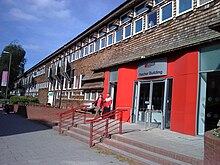
The Faculty of Health and Life Science is De Montfort's largest faculty, housing roughly 500 full-time and part-time staff, as well as approximately 8000 students. It is composed of four interconnected schools: Leicester School of Allied Health Sciences, the School of Applied Social Sciences, the Leicester School of Nursing and Midwifery and the Leicester School of Pharmacy.
The Faculty is based in the Hawthorn Building, which was previously an Arts College; boasting an art-deco turnstile and stage area which now functions as a lecture theatre.David BowieandJimi Hendrixwere reported to have played at the venue in the 1960s.[citation needed]There are ancient archways visible on the lower ground floor; supposedly remnants from a monastery which occupied the site prior to the building's construction.[citation needed]
The four schools interrelate so as to allow collaboration across subject boundaries in teaching, consultancy and research.[citation needed]Between them, the Schools cover not just laboratory sciences but Child, Adolescent and Family Therapy; Community Studies; Community and Criminal Justice; Policing Practice; Criminal Investigation with Policing; Counselling and Psychotherapy; Applied Criminology; Applied Criminology with Psychology; Biomedical Science; Medical Science; Criminology and Criminal Justice; Forensic Science; Health and Wellbeing in Society; Midwifery; Nursing (Adult, Child, Mental Health, Learning Disability); Paramedic Science; Pharmaceutical Sciences; Pharmacy; Psychology; Psychology with Criminology; Psychology with Education Studies; Social Work; and Speech and Language Therapy.

In addition, the Community and Criminal Justice Division in the School of Applied Social Sciences is one of only 3 HEI providers nationally [England and Wales] with regard to the provision of both a Foundation degree and Graduate Diploma [both are work based] in Community and Criminal Justice Degree run in association with the National Offender Management Service.
Computing, Engineering and Media (CEM)
[edit]Originally Faculty of Computing Sciences and Engineering, renamed on 1 October 2008. Descended via the former Leicester Polytechnic from the old Leicester College of Technology. It comprises the School of Engineering, the Leicester Media School and the School of Computing.
The main faculty building is the Queens Building, its unique design means that the building has no need for cooling as it controls the temperature through a series of vents.[38]
Governance
[edit]The university is governed primarily through its 17 person Board of Governors, which is chaired by Ian Squires since January 2020.
Reputation and rankings
[edit]| National rankings | |
|---|---|
| Complete(2025)[39] | 104 |
| Guardian(2025)[40] | 118 |
| Times / Sunday Times(2025)[41] | 113 |
| Global rankings | |
| QS(2025)[42] | 711–720 |
| THE(2025)[43] | 601–800 |
The UKDepartment of Educationawarded the institution a Gold rating in the 2017 Teaching Excellence Framework, describing teaching as being "consistently outstanding" and "of the highest quality found in the UK Higher Education sector".[44]The 2014 Research Excellence Framework described roughly 60% of the University's research activities as "world-leading" or "internationally excellent".[45]
Further, the University was ranked 94th in the UK for the Guardian rankings of 2018,[46]70th by The Complete University Guide for 2019, and 67th by The Times/Sunday Times higher education ranking.[47]
In 2019, the first everTimes Higher Education(THE) University Impact Rankings, a global performance tables that assess universities against the United Nations'Sustainable Development Goals,ranked De Montfort University 50th in the world.[48][49]
Affiliations and partnerships
[edit]The university has special arrangements with more than 80 universities and colleges in over 25 countries, includingNanjing Universitysituated inJiangsu,eastern China. The two universities have launched various initiatives, including a scholarship programme for De Montfort students and doctoral study coupled with English language tuition for students from Nanjing. De Montfort's Institute of Creative Technologies will also advise Nanjing University on a digital recreation ofmedievalChina, following the success of the institute in developing a virtual rendition of Leicester during itsRomanoccupation.[50]
Notable academics
[edit]- See alsoAcademics of De Montfort University.
- Gavin Bryars,composer
- James Stevens Curl,architectural historian, architect and author
- Gary Day
- Christopher Duffy
- Simon Emmerson,composer
- David Greenaway,economist
- Ian Hall
- Robert Hewison
- Christopher Hobbs
- Derek Hockridge
- John Hoskin
- Andrew Hugill
- Colin Jones,artist
- Chris Joseph,writer
- Joanna Scanlan,actress
- Stephen Thomas Knight
- Leigh Landy
- Jim Marshall
- Nicholas J. Phillips
- Kate Pullinger
- John Richards,musician
- Martin Rieser
- Michael Scott
- Debbie Sell
- Dave Smith,composer
- Sue Thomas,author
- John Young,composer
- Lala Meredith-Vula
This article's list of alumnimay not follow Wikipedia'sverifiabilitypolicy.(September 2020) |
Notable alumni
[edit]-
Sir Peter Soulsby,politician andMayor of Leicester
-
Charles Dance,actor
-
Chris Williamson,politician
-
Angela Smith, Baroness Smith of Basildon,politician
-
Park Ji-sung,former professional footballer
-
Manjinder Virk,actress
-
Justin Chadwick,actor
-
Debra Searle,adventurer
-
Emma Twigg,Olympicrower
Academics
[edit]- Louis de Bernières,novelist
- Michael Scott,is the current vice-chancellor ofGlyndŵr UniversityinWrexham,Wales.[51]
- Mohd Sapuan Salit– Professor of material science atUniversiti Putra Malaysia.
Business
[edit]- Tony MayISD
- Janette Pallas,former Head of Enterprise Services
- Nicola Pellow,co-designer of theWWW
- Ken Shuttleworth,architect
- Kingsley Pungong,Sports
Fashion
[edit]- Nichole de Carle,lingerie designer
- Laura Coleman,model, Miss England 2008
- Liam Fahy,footwear designer
- Karolina Laskowska,lingerie designer
- Janet Reger,lingerie designer
- Samuel Ross,fashion designer, founder of A-COLD-WALL*
Health and medicine
[edit]- Allen Lloyd,pharmacist and founder ofLloydsPharmacy
- Debbie Sell,speech and language pathology therapist
- Vijay Patel,pharmacist and founder ofWaymade Plc.
Artists, entertainers and journalists
[edit]- John "TotalBiscuit" Bain,game commentator
- John Buckley,sculptor
- Audrey Barker,artist
- Zarina Bhimji,photographer and filmmaker
- Justin Chadwick,actor, television and film director
- JS Clayden,vocalist forPitchshifter,founder ofPSI Records
- Helen Mary Coaton,sculptor
- Marverine Cole,radio and television presenter
- Dorothy Cross,artist and sculptor
- Charles Dance,actor
- Pete Donaldson,broadcaster
- Keeley Donovan,broadcaster
- Alun Evans,journalist, CEO ofFootball Association of Wales
- Mike Foyle,music producer
- Christian Furr,artist
- MJ Hibbett,singer-songwriter
- Sarah Keyworth,comedian
- Akram Khan,dancer
- Jemisha Maadhavji,painter
- Nero,music producer
- Jamie-Lee O'Donnell,actor
- QBoy,rapper and producer
- Simon Rimmer,chef and television presenter
- Nick Ruston,artist and sculptor
- David Shrigley,artist
- Simon Wells,film director
Law
[edit]- Michael BeloffKC,barrister[52][failed verification]
- Geoffrey BindmanKC,human rights lawyer[53][failed verification]
- John Geoffrey JonesKC,judge, president of theMental Health Review Tribunalfor England and Wales
- Helena Kennedy, Baroness Kennedy of The ShawsKC,barrister, broadcaster, andLabourmember of theHouse of Lords.[54][failed verification]
Politics and government
[edit]- Simba Makoni,Zimbabwean politician, former Minister of Finance and Economic Development (2000–2002)
- Neo Masisi,First Lady of Botswana
- Margot Parker,UK Independence PartyMEP
- Andy ReedOBE,former Labour Party MP forLoughborough
- Dean Russell,British Conservative Party Politician, MP forWatford
- Angela Smith,former British Labour Party politician MP forBasildon
- Sir Peter Soulsby,MP, British Labour Party politician andMayor of Leicester
- David Taylor,British Labour Party politician, MP forNorth West Leicestershire
- Claudia Webbe,British politician, former MP forLeicester East
- Shivani Raja,British Conservative Party politician, MP forLeicester East
Sport
[edit]- MS Dhoni,Indian Cricketer and only captain in the world who has won 3 ICC trophies (2007 T20 world cup,2011 Cricket World Cup,2013 ICC Champions Trophy)
- Harry Ellis,England Rugby Union international
- Eddie the Eagle,ski jumper
- Kim Joo-Sung,Korean international footballer
- Lewis MoodyMBE,England rugby union captain
- Geordan Murphy,Ireland rugby union international, director of rugby forLeicester Tigers
- Park Ji-sung,Korean International footballer
- Budge Pountney,Scotland rugby union international, director of rugby forNorthampton Saints
- Emma Twigg,olympic Rower for New Zealand
See also
[edit]Notes
[edit]References
[edit]- ^ab"Annual Accounts 2021/22"(PDF).De Montfort University.Retrieved21 February2023.
- ^abc"Where do HE students study?".Higher Education Statistics Agency.Retrieved23 September2024.
- ^ab"Annual Reports and Financial Statements 2014–2015"(PDF).De Montfort University.Retrieved30 March2016.
- ^"Teaching Excellence Framework 2023 Outcomes".Office for Students.Retrieved28 September2023.
- ^abcd"Key events before 1992".De Montfort University.Archived fromthe originalon 27 September 2011.
- ^ab"A vibrant history".De Montfort University.Retrieved1 March2013.
- ^"Key events after 1992".De Montfort University.Archived fromthe originalon 27 September 2011.
- ^"De Montfort University".Times Higher Education.Retrieved18 September2019.
- ^Richmond, Colin(1997). "Why the University should not be named after de Montfort (or why I don't drive a Volkswagen)".Patterns of Prejudice.31(2): 19–29.doi:10.1080/0031322X.1997.9970221.
- ^Kushner, Tony; Griffiths, Toni (2022). "Appendix: A symposium on Simon de Montfort, the Jews and the politics of naming".Jewish Culture and History.23(1): 83–102.doi:10.1080/1462169X.2022.2019984.S2CID245922684.
- ^"Campaign to Change the Name of De Montfort University: A statement from your Executive Officer Team".De Montfort Students' Union.18 November 2020.Retrieved19 November2020.
- ^"De Montfort University students call for 'anti-Semitic' name to go".BBC News.19 November 2020.
- ^"Performance Arts Centre for Excellence (PACE) Building".De Montfort University.Archived fromthe originalon 12 February 2012.
- ^"Hugh Aston Building".De Montfort University.Archived fromthe originalon 26 May 2012.Retrieved20 December2010.
- ^Weale, Sally; correspondent, Sally Weale Education (1 July 2019)."University vice-chancellor given £270k payoff after resigning".The Guardian.ISSN0261-3077.Retrieved15 February2023.
{{cite news}}:|last2=has generic name (help) - ^"DMU Campus Map"(PDF).De Montfort University.December 2016.
- ^Billson, Charles James(1920)..Leicester – viaWikisource.
{{citation}}:CS1 maint: location missing publisher (link) - ^"Leicester Castle and the Magazine Gateway: Scheduled Monument".Leicester City Council.Archived fromthe originalon 5 October 2013.Retrieved8 March2012.
- ^"Trinity House, formerly Trinity Hospital Almshouses".British Listed Buildings.Retrieved8 March2012.
- ^Carson, Anne;Ashdown-Hill, John;et al. (2014).Finding Richard III.Horstead:Imprimis Imprimatur.ISBN978-0-95768-402-7.
- ^"DMU Campus Development".De Montfort University.Archived fromthe originalon 27 January 2012.
- ^"The Vijay Patel Building".De Montfort University.Archived fromthe originalon 20 May 2018.Retrieved26 May2018.
- ^"DMU Masterplan - Leicester City Campus".De Montfort University.Archived fromthe originalon 19 May 2011.Retrieved16 July2015.
- ^"Demon FM".demonfm.co.uk.
- ^"Demon TV".demontv.co.uk.Archived fromthe originalon 18 October 2016.Retrieved7 February2016.
- ^"The Demon".demontfortstudents.com.Archived fromthe originalon 5 December 2007.
- ^"Campus Centre Building".Archived fromthe originalon 14 August 2011.Retrieved20 December2010.
- ^"Library".De Montfort University.Archived fromthe originalon 6 March 2012.
- ^"Library Disability Services".De Montfort University.Archived fromthe originalon 31 January 2018.Retrieved26 May2018.
- ^"National Teaching Fellows".De Montfort University.Archived fromthe originalon 14 August 2011.
- ^"Cultural Exchanges festival".De Montfort University.Archived fromthe originalon 22 January 2011.
- ^"De Montfort University Contour Fashion Graduate Show 2002".BBC News.27 June 2002.
- ^"Footwear Design BA (Hons)".De Montfort University.Retrieved26 May2018.
- ^"International Partnerships: Daly College Business School".De Montfort University.Archived fromthe originalon 28 May 2011.Retrieved20 December2010.
- ^"Leicester Business School".De Montfort University.Archived fromthe originalon 14 August 2011.
- ^"Faculties – Index".De Montfort University.Archived fromthe originalon 16 August 2011.
- ^"Hugh Aston building".De Montfort University.Archived fromthe originalon 19 May 2011.
- ^"Queens Building - Our Commons Wiki".wiki.our.dmu.ac.uk.
- ^"Complete University Guide 2025".The Complete University Guide. 14 May 2024.
- ^"Guardian University Guide 2025".The Guardian.7 September 2024.
- ^"Good University Guide 2025".The Times.20 September 2024.
- ^"QS World University Rankings 2025".Quacquarelli Symonds Ltd. 4 June 2024.
- ^"THE World University Rankings 2025".Times Higher Education. 9 October 2024.
- ^"Teaching Excellence Framework Outcomes".Office for Students.Retrieved26 May2018.
- ^"Results & Submissions".Higher Education Funding Council for England.2014.Retrieved26 May2018.
- ^"University league tables 2018".The Guardian.Retrieved14 May2018.
- ^"Best universities in the UK".Times Higher Education.5 September 2017.Retrieved14 May2018.
- ^"DMU ranked in top 50 universities in the world for sustainability".www.dmu.ac.uk.Retrieved18 September2019.
- ^"DMU and Sustainable Development Goals | Sustainability Exchange".www.sustainabilityexchange.ac.uk.Retrieved18 September2019.
- ^"Collaboration with Nanjing University".De Montfort University.14 March 2011. Archived fromthe originalon 14 August 2011.Retrieved17 June2012.
- ^"Glyndŵr University's Board of Governors".Glyndŵr University.Retrieved19 July2008.[dead link]
- ^"Legendary advocate Michael Beloff QC is to receive an Honorary Degree from De Montfort University in Leicester".De Montfort University.8 July 2010. Archived fromthe originalon 4 March 2016.Retrieved26 May2018.
- ^"Sir Geoffrey Bindman QC (Hon)".Bindmans.Retrieved16 July2015.
- ^"Helena Kennedy QC".Doughty Street Chambers.Archived fromthe originalon 7 April 2013.Retrieved26 May2018.
External links
[edit]- Official website
- De Montfort Students' Union– Official website
- De Montfort University archives












